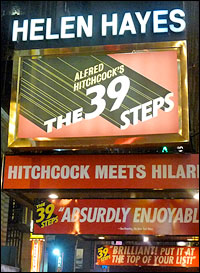
*
Ask Playbill.com answers your (and sometimes our own) theatre-related questions. To ask a question, email [email protected]. Please specify how you would like your name displayed and please include the city in which you live.
Question: Why do Broadway shows move from one theatre to another, sometimes up to three or four times during their initial run? How long does it take to move a show? — Craig Hodges of Memphis, TN.
Real estate is one of the most critical elements when putting together a Broadway show. It is a finite resource—there are only a few dozen or so Broadway houses—and finding the right space for your particular attraction is a matter of great concern to a producer. Trouble is, other producers soon become covetous of that same theatre you've secured. And so, on occasion—sometimes due of the wishes of the theatre owner; or because the show in question was initially intended as a limited run, allowing the theatre owner to book another show right behind it—a show must give up its original home and move into new digs. This can be the case even if the show is a popular hit.
The most recent notable example of this phenomenon was the English comedy The 39 Steps, based on the Alfred Hitchcock thriller of the same name. It began in January 2008 as part of the subscription series at the not-for-profit Roundabout Theatre Company's American Airlines Theatre. When it proved successful, it transferred and reopened as a commercial venture at the Cort Theatre in April 2008, since the AA Theatre was already set to present another attraction after 39 Steps. The play stayed there until January 2009, when it jumped to the smaller Helen Hayes Theatre, to make room at the Cort for the incoming Will Ferrell act You're Welcome, America. "Basically, our landlords asked us to leave," said Roy Gabay, who has been general manager of 39 Steps during its entire run. "While it's an additional expense to transfer" — a move can cost up to $200,000, said Gabay — "we felt it would be offset by the continued audience for the show." Indeed, he proved correct. The play remained at the Hayes until it closed in January 2010, and, after that, moved to Off-Broadway's New World Stages, where it remains.
| |
 |
|
| The third 39 Steps marquee |
Another famous example of a show on the move is the still-running revival of the Kander and Ebb musical Chicago. It opened at the Richard Rodgers Theatre in fall 1996 to exultant reviews. Just three months later, however, it was bumped to the Shubert Theatre. Why? Expecting only a limited run for Chicago, the owners of the Rodgers had booked that theatre with an incoming new show, Steel Pier — another show by John Kander and Fred Ebb. But the Shubert Theatre is the jewel in the Shubert Organization's crown, and typically reserved for only the most prestigious shows. To make room for a much-anticipated new revival of Gyspy starring Bernadette Papers, in January 2003 Chicago was made to move to the Ambassador Theatre. It's been there ever since.
Other famous moves in Broadway history: South Pacific played at the Majestic for four years before playing its final six months at the Broadway Theatre; Les Miserables opened at the Broadway Theatre in 1987, and then moved to the Imperial in 1990; The Music Man spent most of its life at the Majestic, but played out its final half a year at the Broadway Theatre.
Gabay commented that such moves are rare, "because it is so expensive." However, he said, they have been more common in recent years due to the real-estate crunch, with many more shows vying for a limited amount of theatres.
(Write us at [email protected].)











